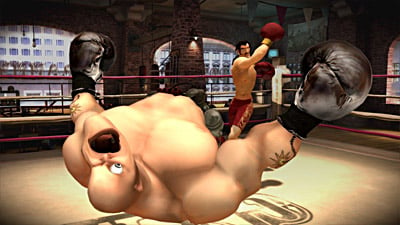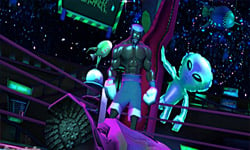The first time we read about the Wii-mote/Nunchuk combo, among our first thoughts was, “That would be really cool in a boxing game.” Wii Sports came along and verified this, but while it’s a lot of fun to play, the boxing mini-game in that title doesn’t exactly max out the Wii’s capabilities. Since then there have been a few attempts, but none have captured the energy and violence of a real match.

Just in time for Christmas 2008, along comes the delightfully over-the-top FaceBreaker K.O. Party. However, due to its many flaws it’s not the boxing game we’ve been waiting for, and it plays more like a traditional fighter, but it’s pretty much the best Wii owners have.
The first thing anyone will notice is the game’s ridiculously cartoonish style, presented through terrific-for-the-Wii graphics. The characters are all played-up stereotypes (a few girls who look like Pink, a huge, dumb bodybuilder named Brick, a Joker knockoff called Socks), and one of the arenas is a trailer park. The announcer has a crazy voice that’s amusing when you’re winning, but incredibly annoying when you’re losing and frustrated. The intros to each fight always look great, are sometimes laugh-out-loud funny (at least the first time), and, at any rate, can be skipped with a press of the plus-sign button. Since it’s an EA game, the developers had plenty of licensed music to choose from, and you’ll be listening to lots of new hard rock (and seeing ads for the songs in the lower left-hand corner).
The action takes place in a 3-D ring, and you view the boxers from the side, as in a fighting game, rather than from the first-person, over-the-shoulder, and moving-camera views employed in most other boxing titles. The fighting system and controls are brilliant in their simplicity; aiming for a casual market, the developers have eschewed the absurd complexity in vogue in modern fighters’ move lists. You’ll never have to do anything more complicated than holding one button and pressing another.

You move around the ring with the Nunchuk joystick. Punching with or flicking your left and right hands will make your character jab with his respective hand (be sure not to fully extend your arms, or you’ll hurt your elbows). Holding the B button switches your attacks and blocks from high to low, the D-pad throws, and Z blocks. Leaning back will “charge” your punches and dodge attacks; charging and blocking at the same time parries. Holding A while jabbing executes a special move (or “Breaker”). By hitting your opponent several times without getting hit yourself, you charge a yellow meter, and the more that meter is charged, the more damage your special moves do. When it’s charged all the way, you can execute a “FaceBreaker” for an instant K.O.
That’s about all there is to it, and it doesn’t change depending on what character you select (though each character does have strengths and weaknesses such as power, reach, speed, etc.). It’s simple enough that anyone can pick it up and learn quickly, but there’s enough nuance that an advanced player will enjoy learning the game thoroughly. As a tutorial explains, blocks and dodges work on jabs and charged punches, but not Breakers, while a jab will stop a Breaker.

It would be the perfect Wii fighting game, but for two fatal problems. The first is that the action is way, way too fast. There really isn’t enough time to react to anything, and on top of that, the motion controls aren’t really given to precise timing.
This issue greatly affects the multiplayer modes, which tend to devolve into flailing matches. It’s fun for a few minutes at a party (we suspect they chose the game’s subtitle carefully), but it’s hard to learn the game on any deeper level. There are three multiplayer modes: “Punch-O-Matic,” a collection of weird mini-games that include matches with bent rules (only a certain kind of attack will work, or the game will speed up and slow down) and some bizarre contests (such as shooting a bird with the Wii-mote pointer); “T.K.O.,” a team knock-out tournament; and “Arcade,” a one-off battle. Punch-O-Matic and T.K.O. work with two to four players, but two is the max for Arcade.

Fatal problem number two is the A.I. in the single-player modes, which comprise Arcade and “Brawl for it All,” a season mode of sorts where you try to win belts. Arcade has four difficulty levels (practice, easy, medium, hard), Brawl for it All has two (lightweight, heavyweight). With the exception of the practice and easy levels of Arcade (in the former you’re just punching a dummy), it’s just really, really difficult to win. You have to find enemies’ weaknesses by trying to note how much damage each of your attacks does, while they pummel you mercilessly at 100 miles an hour. Even knowing the weaknesses, it’s hard to land a blow at all half the time. Players would be able to content themselves with Arcade’s easy mode, but that one’s too easy, with the opponents pretty much waiting around for you to hit them.
It’s a testament to the bad position in which the Wii finds itself with third-party titles that we’re almost tempted to forgive these sins. EA, to its credit, put a whole lot of effort into this game, making so many adjustments from the Xbox and PlayStation versions that it felt compelled to change the name (the other incarnations are just called FaceBreaker). In fact, the other versions’ reviewers have complained about many of the issues that bothered us in the Wii title, so they’re flaws in the game itself, not the fault of a lazy porting process. Aside from the boxing game in Wii Sports, this is certainly among the best motion-controlled fighters the Wii has to offer. So kudos to EA for not leaving Wii owners out to dry.
We can almost forgive it all, but not quite. For someone who absolutely must have a new fighting game at his next Wii get-together with friends, sure, FaceBreaker K.O. Party is the way to go, and it’s only 40 bucks. But for anyone looking to fight a friend for hours at a time (on one console, of course; the Wii version did lose online capabilities), or to enjoy a robust and reasonably challenging single-player mode, this just isn’t comparable to something from, say, the Street Fighter, Mortal Kombat, Tekken, or Soul Calibur franchises. If you want to punch with your Wii-mote and love it, you’ll have to stick with Wii Sports for at least a little while longer.
RATING OUT OF 5 RATING DESCRIPTION 4.8 Graphics
Some of the best visuals the Wii has seen, in an over-the-top cartoon style. 4.2 Control
They’re very responsive and take advantage of the Wii’s motion controls, but the game is so fast-paced that it’s hard to keep up with gestures. 3.8 Music / Sound FX / Voice Acting
It’s an EA game, so there are plenty of licensed tunes, and the sound effects are as over-the-top as the graphics. 2.9
Play Value
It’s too fast to play strategically, and the enemy A.I. is way too difficult to beat.
3.2 Overall Rating – Fair
Not an average. See Rating legend above for a final score breakdown.
Game Features:
